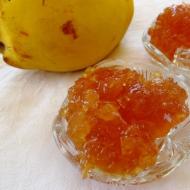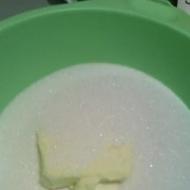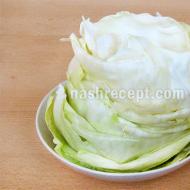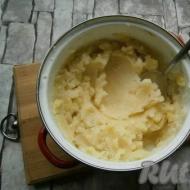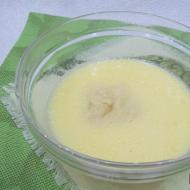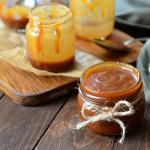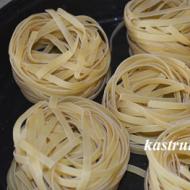
How and where to store moonshine. Conditions affecting the shelf life of moonshine (vodka, alcohol). Storage conditions for vodka or moonshine
Cloudiness of crystal clear moonshine (if more than 10 days have passed after dilution with water) and (or) the appearance of sediment in the form of flakes is a sign of improper storage. Often not only the appearance, but also the quality deteriorates. We will consider the parameters that affect the shelf life of moonshine. By creating the right conditions, the drink can be left for decades. But just one mistake can irrevocably damage the product. All of the above tips are also relevant for other strong drinks: vodka, ethyl alcohol, cognac, whiskey, etc.
1. Container. The most important factor on which the shelf life of strong alcohol depends by 80-90%, since alcohol is an active substance that reacts with most materials, which can result in the release of harmful impurities. At home, the ideal packaging options are glass bottles, carboys and cans for preservation.
It is better to use bottles from official vodka (with the “original” cork), into which no other substances were poured. If food or liquids have been in containers for even a short time, then before use the container must be thoroughly washed and dried, and then checked for the presence of third-party odors that could spoil the aroma of the distillate.
Another mandatory condition for containers for storing moonshine is tightness. In open air, alcohol evaporates quickly. Even a poorly screwed cap (cap) can cause a decrease in strength due to evaporation, leaving only water. The corks should fit snugly to the neck of the bottle.
It is better to roll up jars with steel lids, since they are more reliable and safer than nylon lids. Nylon is one of the types of plastic that, when in contact with alcohol, can release harmful substances, this will be discussed further.

 Metal lids are preferable to nylon ones
Metal lids are preferable to nylon ones You cannot pour moonshine into containers where non-food products, such as gasoline or glue, were previously stored, since it is very difficult to wash such containers and the risk of irreversibly spoiling the distillate is very high.
For very large volumes, stainless steel barrels used in industry are recommended. Food grade stainless steel, like glass, does not react with alcohol and is therefore safe. But aluminum cans and enamel cookware are not suitable.

 Food grade stainless steel barrels are a good solution for large volumes
Food grade stainless steel barrels are a good solution for large volumes Storing moonshine and other alcoholic beverages with a strength higher than 15-20 degrees in plastic containers is strictly prohibited, the only exception is special plastic intended for strong alcohol, but this material rarely appears in retail sales.
Alcohol corrodes most plastic bottles, as a result the moonshine becomes cloudy, flakes or loose sediment appear at the bottom, and an unpleasant odor appears. There have been cases when alcohol “burned through” thin plastic.

 Cloudy moonshine in a plastic container
Cloudy moonshine in a plastic container But even if moonshine has not visually changed after storage in a plastic bottle, this does not mean that the drink is safe; many harmful substances cannot be determined organoleptically (by taste and smell). When alcohol reacts with different types of plastic, carcinogens such as formaldehyde (phenol) and styrene are released.
Many home distillers prefer to store moonshine in oak barrels. Sometimes such a decision is justified, but this method has a number of disadvantages. Firstly, you need to purchase and create normal storage conditions, including temperature and humidity, then periodically check the safety of the barrel. Secondly, evaporation should be taken into account - regardless of the volume, losses in the best case will amount to about a liter of poured distillate per year. Thirdly, the taste of moonshine will change. Therefore, I consider barrels as a method of preparing an individual drink, but not as a storage container.

 After aging in a barrel, moonshine changes color and taste
After aging in a barrel, moonshine changes color and taste 2. Composition. Moonshine may contain third-party additives (except alcohol and water): sugar, citric acid, herbal extracts, fruits, berries, other substances that improve the aroma or taste of moonshine, as well as essential oils and other impurities remaining due to improper distillation and (or) cleaning. It is impossible to predict how all these substances will behave after prolonged exposure.
It all depends on the composition, concentration and chemical reactions of third-party components between themselves on the one hand, and alcohol on the other. Typically, natural additives precipitate or become cloudy when exposed to direct sunlight, which only worsens the visual perception of the drink, but does not affect the quality.
The general rule here is to store moonshine with additives for no more than a year, and for several years or longer, store only well-purified distillate or alcohol diluted with high-quality water without adding third-party substances.
3. Conditions. Proper temperature and humidity along with a lack of sunlight will block or slow down most chemical reactions. This is very important when storing moonshine with additives, but it is also desirable to create optimal conditions for “pure” distillate, especially if the drink is stored for a long period - 3-10 years.
I recommend placing the container with moonshine in a dark room (or at least away from direct sunlight) with a temperature of 5-20°C and a relative humidity of 85%. Be sure to periodically check the appearance of the drink and its tightness.
Video: Kiwi tincture at home - a simple recipe with vodka
Cloudiness of crystal clear moonshine (if more than 10 days have passed after dilution with water) and (or) the appearance of sediment in the form of flakes is a sign of improper storage. Often not only the appearance, but also the quality deteriorates. We will consider the parameters that affect the shelf life of moonshine. By creating the right conditions, the drink can be left for decades. But just one mistake can irrevocably damage the product. All of the above tips are also relevant for other strong drinks: vodka, ethyl alcohol, cognac, whiskey, etc.
Video: Cleaning moonshine with activated carbon. How to clean moonshine? DIY carbon filter
1. Container. The most important factor on which the shelf life of strong alcohol depends by 80-90%, since alcohol is an active substance that reacts with most materials, which can result in the release of harmful impurities. At home, the ideal packaging options are glass bottles, carboys and cans for preservation.
It is better to use bottles from official vodka (with the “original” cork), into which no other substances were poured. If food or liquids have been in containers for even a short time, then before use the container must be thoroughly washed and dried, and then checked for the presence of third-party odors that could spoil the aroma of the distillate.
Another mandatory condition for containers for storing moonshine is tightness. In open air, alcohol evaporates quickly. Even a poorly screwed cap (cap) can cause a decrease in strength due to evaporation, leaving only water. The corks should fit snugly to the neck of the bottle.
It is better to roll up jars with steel lids, since they are more reliable and safer than nylon lids. Nylon is one of the types of plastic that, when in contact with alcohol, can release harmful substances, this will be discussed further.

Metal lids are preferable to nylon ones
You cannot pour moonshine into containers where non-food products, such as gasoline or glue, were previously stored, since it is very difficult to wash such containers and the risk of irreversibly spoiling the distillate is very high.
For very large volumes, stainless steel barrels used in industry are recommended. Food grade stainless steel, like glass, does not react with alcohol and is therefore safe. But aluminum cans and enamel cookware are not suitable.

Food grade stainless steel barrels are a good solution for large volumes
Storing moonshine and other alcoholic beverages with a strength higher than 15-20 degrees in plastic containers is strictly prohibited, the only exception is special plastic intended for strong alcohol, but this material rarely appears in retail sales.
Alcohol corrodes most plastic bottles, as a result the moonshine becomes cloudy, flakes or loose sediment appear at the bottom, and an unpleasant odor appears. There have been cases when alcohol “burned through” thin plastic.

Cloudy moonshine in a plastic container
But even if moonshine has not visually changed after storage in a plastic bottle, this does not mean that the drink is safe; many harmful substances cannot be determined organoleptically (by taste and smell). When alcohol reacts with different types of plastic, carcinogens such as formaldehyde (phenol) and styrene are released.
Many home distillers prefer to store moonshine in oak barrels. Sometimes such a decision is justified, but this method has a number of disadvantages. Firstly, you need to purchase and prepare a barrel for use, create normal storage conditions, including temperature and humidity, then periodically check the safety of the barrel. Secondly, evaporation should be taken into account - regardless of the volume, losses in the best case will amount to about a liter of poured distillate per year. Thirdly, the taste of moonshine will change. Therefore, I consider barrels as a method of preparing an individual drink, but not as a storage container.

After aging in a barrel, moonshine changes color and taste
2. Composition. Moonshine may contain third-party additives (except alcohol and water): sugar, citric acid, herbal extracts, fruits, berries, other substances that improve the aroma or taste of moonshine, as well as essential oils and other impurities remaining due to improper distillation and (or) cleaning. It is impossible to predict how all these substances will behave after prolonged exposure.
It all depends on the composition, concentration and chemical reactions of third-party components between themselves on the one hand, and alcohol on the other. Typically, natural additives precipitate or become cloudy when exposed to direct sunlight, which only worsens the visual perception of the drink, but does not affect the quality.
The general rule here is to store moonshine with additives for no more than a year, and for several years or longer, store only well-purified distillate or alcohol diluted with high-quality water without adding third-party substances.
3. Conditions. Proper temperature and humidity along with a lack of sunlight will block or slow down most chemical reactions. This is very important when storing moonshine with additives, but it is also desirable to create optimal conditions for “pure” distillate, especially if the drink is stored for a long period - 3-10 years.
I recommend placing the container with moonshine in a dark room (or at least away from direct sunlight) with a temperature of 5-20°C and a relative humidity of 85%. Be sure to periodically check the appearance of the drink and its tightness.
Attention, TODAY only!
OTHER
Beginner winemakers often lack suitable containers for storing finished drinks - dark wine bottles...
Video: Sparkling wine. White wineVideo: How to make Champagne wineSo that the purchased champagne does not spoil and...
During festive feasts one cannot do without strong alcoholic drinks. Alcoholic beverages are in demand today...
Video: How to Store Cognac Conditions for storing cognac Video: Galileo. Best before date …
Video: ETERNAL FOOD. Expiration date of products. How long can food be stored? All food products have a certain period...
As you know, every food product has its own expiration date and vodka is no exception. Of course, it can be stored...
Video: How does the expiration date differ from the shelf life? Vodka is a drink that every person purchases at least once a…
Video: How to Store CognacThe taste of cognac largely depends on how it is stored correctly. So that the drink does not spoil and...
Video: Preparing an oak barrel for distillates. Oak barrel. Moonshine. San SanychAny alcoholic drink needs...
Purifying moonshine with milk: reliable, safe, environmentally friendly There are various options for purifying moonshine. If her...
Almost any food product has its own shelf life. Even for pure preservatives (such as table salt)…
The prepared product is tasty and pure as crystal - a source of pride for every distiller.
But one more issue needs to be resolved - choosing the right bottles for moonshine and providing it with proper storage conditions so that the product does not deteriorate over time.
After all, with well-organized storage, without interaction with potentially harmful substances, moonshine can be stored for years and even decades.
Depending on the needs, the container is also selected. Let's consider which materials are suitable for long-term storage and under what conditions. What is better to choose for short-term contact with alcohol? For example, during transportation.
Plastic containers
In terms of frequency of use, plastic containers are only slightly inferior to glass. These include bottles for various drinks, carbonated water, and plastic canisters of various capacities. Many have heard about the potential harm of such dishes, because plastic can enter into chemical reactions with alcohol.
But let’s keep in mind that plastic is different from plastic. For example, bottles for regular or sparkling water are made from plastic that is less resistant to chemical processes. Branded bottles from Coca and Pepsi Cola, Fanta are better protected from interaction with acid. Bottles are made using special technology so that they do not react with alcohol.
So think about it - which of the listed bottles should you choose as a container for alcohol-containing substances? To be fair, we note that modern plastics are in many ways superior to those that were at the dawn of the appearance of Pet bottles.
But even despite manufacturers’ assurances that plastic containers intended for food are completely safe, be careful:
- Keep a container of alcohol away from heat sources, because it is highly flammable. And in combination with high-degree products it can provoke a lightning fire.
- Protect plastic bottles from the light, especially direct sunlight. They speed up reactions and the taste of your elite homemade alcohol can be transformed beyond recognition. And not in the best sense.
- Do not store alcohol in plastic for longer than six months. It is better to use it only for a short time. For example, for transportation and forays into nature, you can’t think of a better container: it’s reliable, airtight, and won’t break if it accidentally falls.
Glass bottles
The most preferable are specially purchased new bottles. Suitable for store-bought vodka, champagne, cognac, and other alcohol. Necessarily - with “native” twists, nylon or cork plugs.
Glass does not react at all with the chemicals that moonshine contains. It’s not for nothing that among distillers there is even such a concept: give the drink a certain time after preparation. "relax in the glass". It is understood that this is how the drink stabilizes the taste and aroma, it will become softer, and it will be more pleasant to drink.
Carefully. Today, many manufacturers are trying to protect their products from counterfeits by equipping their bottles with “tricky” stoppers, when you can pour vodka out of a bottle, but you cannot put it back in. If you are convinced that it is not possible to “punch” a quality hole in such a bottle, it is better to throw it away and not lose a valuable product trying to fill it.
When there is an oversupply of production, or in cases where moonshine is used for the future (for the wedding of a granddaughter who is 10 years old), three-liter jars are often sealed with metal lids using a key. Is this the right decision? Yes and no.
Yes - because that's how we are We won’t let a single degree evaporate. And no - for the reason that, as we have already mentioned, alcohol can gradually react with metal surfaces, and the lid is the same tin, which can completely distort the aroma of good moonshine and give it a harsh metallic taste.

Therefore, remember a few rules:
- do not roll up the jars yourself cheap caps, on which there are, at best, traces of chemically resistant varnish. The lids must be varnished, from a normal manufacturer;
- take a look at what's on sale good capacity jars(2 and even 3 liters) under screw caps. They are more reliable, thicker, coated with a layer of powder paint, and do not react with acids and alcohol;
Advice. Be generous and buy new lids, don't reuse them. Invariably appearing cracks in the coating, scratches during closing/opening, and transportation will shorten the service life and can also ruin the fruits of your labor.
- try to store moonshine in jars no more than two years(during seaming, the varnish layer is invariably damaged, then oxidizes, the lids rust). If there is a need for further storage, open the can and try the drink. After making sure that the taste has not changed, re-roll with a new high-quality lid.
Some people store alcohol for a long time in crystal decanters with ground plugs. Yes, alcohol does not evaporate like that, but the crystal itself contains lead oxide, which gradually “feeds” alcohol, and its consumption is dangerous to health!
Oak barrels
In all countries, elite alcohol is aged in oak barrels. Moonshine is no exception. Having spent even several months in a hermetically sealed barrel, moonshine acquires a noble whiskey or cognac color, its taste also improves.

This is great, but don’t forget that over time, moonshine in an oak barrel loses its strength a little (the alcohol evaporates even through the micropores of the wood). Although, as we know, elite Hennessy can even contain hundred-year-old alcohols.
Note. Small barrels are not suitable for long-term storage. The moonshine stored in them picks up too many tannins, turning into an unpleasant “plinth”.
Stainless steel containers
Just like glass, food-grade stainless steel does not react with alcohol, acids and other chemicals. elements. Unlike glass, the material is durable, and moonshine can be stored in containers made from it for decades. The only condition is tank tightness.
The lid on it should be screw-on. It is advisable to equip it with a silicone gasket (silicone, unlike nylon and plastic, is inert to alcohol).
Attention. To make sure you are dealing with food grade stainless steel, hold a refrigerator magnet to the container. Magnets do not stick to stainless steel intended for food storage!

Storage conditions for homemade alcohol
The general requirements for storing alcohol are:
- sterile, cleanly washed jars, bottles and other containers;
- sealed packaging (cork, lid) through which alcohol cannot evaporate;
- keeping containers with moonshine away from heating devices of any type. Already at +70°C an explosion is possible;
- the best temperature is about +5°C. Moreover, sub-zero temperatures are preferable to high ones;
- storage place - in the dark. With sufficient quantities of moonshine, this is a cellar; with insignificant quantities, it is a refrigerator.
Important. Each product has its own shelf life without loss of quality.
For pure moonshine without impurities, it is theoretically calculated five years if stored properly. In practice - much more. Most are stored for a year or half a year, so there is no need to store them in buckets and cans.
Labels for bottles of moonshine
 For every bottle of moonshine, a label is not a luxury, but a necessity. Why is it needed and what exactly should I indicate?
For every bottle of moonshine, a label is not a luxury, but a necessity. Why is it needed and what exactly should I indicate?
- So as not to forget, what kind of moonshine enclosed in this bottle (, etc.).
- Date of manufacture. Especially important for those that need to be used first.
- Fortress drink (see: ).
- Peculiarities, including how successful the moonshine in this bottle is: unsuccessful; traditional; elite; infused in an oak barrel (and how much), etc.
- Purpose. What can you indicate here? For example, for guests; for dear guests; for rubbing; for tinctures and what else your imagination tells you.
Temporary labels
Labels can be temporary, so to speak, for personal use. As a rule, in this case you don’t have to bother with appearance.
Just buy it at a stationery store self-adhesive price tags(they come in different types and sizes), indicate the parameters you need on them and stick them on the dishes with moonshine.
Permanent branded
Your personal labels will reflect not only the identity of the alcohol, but also its status, quality. So start creating your brand identity. What is needed for this?
- If you are good at Photoshop and know what exactly you would like to see on your own label, Google the images, select the ones you need and process them. You can even insert a photo of the author of the drink (that is, yourself) if you wish.
- Go online and look for ready-made label templates. Many sites offer to download them for free.
- If you haven’t mastered Photoshop yet, you can at least work in Paint. With this program you can remove unnecessary things from the template and add something you need. But complex manipulations (insert, increase something, decrease something) are unlikely to be done.
- Transfer the finished image into Word, place 4 labels on a standard sheet of paper and print it on a printer.
- Carefully cut and paste. It is convenient to use a glue stick.
- A typical household printer does not produce durable images. If a drop of water or moonshine falls somewhere, the stain will spread and the whole appearance will deteriorate. Therefore, you need to protect the label from moisture. For this:
- Carefully apply masking tape around the label;
- spray hairspray onto the label;
- remove the tape. Now your label is not only beautiful, but also water-repellent.

Peculiarities. To avoid gluing labels yourself the old fashioned way of spreading glue, go to an office supply store and buy self-adhesive paper with a sticky backing.
More often it is sold under the name " applique paper" It can be white or color (which can also be interesting, especially if your image is black and white or does not have a color printer).
Basic requirements for appearance
Beautifully made labels are intended to be placed on the table in front of guests, or even to present a bottle or another to friends. This is your trademark quality.
- Reference. New moonshine bottles along with twists can be purchased at a distillery store (including online stores).
Before you get a natural homemade product, you first boil the mash. There are many ways to make it, but no matter what it was made from, you need to properly store the mash and the moonshine that comes from it.
An important storage condition is compliance with the recommended temperature conditions. If this is not done, the product will be spoiled.
How to properly store moonshine
The finished product should be cooled after distillation until it reaches room temperature. After this, it needs to be poured into a pre-prepared container. It is important that it is not just clean, but sterile, then it will be stored for a long time.
Which container is better?
In addition, it is good to store it at home:
- in oak barrels;
- in a metal can.
Where to store moonshine
For storage, you need to choose a place where the temperature will be maintained. These are optimal conditions under which the drink will remain suitable for consumption throughout the year.
Best storage places:
- cellar;
- basement;
- balcony in winter;
- garage.
How long moonshine can be stored depends on the container and temperature. The lower it is, the longer the shelf life. At 3°C-5°C it can remain fresh for up to 24 months.
The optimal conditions for storing moonshine are sterile glass containers and a temperature not higher than 5°C.
How to properly store mash
Each recipe is based on the principle of fermentation, so it is important to maintain a suitable temperature for storage. In addition, it is better to use the storage container in which the mash was prepared, since it has already undergone the sterilization process.
Which container is better?
If it is not possible to store a large brew, it must be poured into a clean, dry, sterilized container for storage. After fermentation, the ripened finished mass should be poured into prepared containers before distillation:
- glass jars;
- glass bottles;
- metal barrels;
- plastic bottles.
Where to store the mash
Many people are interested in whether it is possible to store moonshine in the kitchen. The answer is – not recommended. It should be a dark and cool place, the cooler it is, the longer it will be usable. Places where it is better to store ripened fermented mash are:
- balcony;
- cellar;
- basement;
- garage;
- fridge.
In the summer, you can fill the bathroom with cold water and keep the container with mash, changing it periodically. The timing is directly affected by temperature, but it should be remembered that this is not a long-term storage product.
At temperatures from 3°C to 5°C, mash can be stored for up to 7 days. At room temperature – no longer than 1 day.
FAQ
How to store mash for drinking after fermentation?
Sugar mash after fermentation should be poured into clean, sterile glass jars and placed in a dark, dry and cool place with a temperature no higher than 5°C.
Is it possible to store moonshine in plastic bottles?
No you can not.
How long can moonshine be stored in a plastic bottle?
It is advisable not to store moonshine in a plastic bottle at all.
Is it possible to store moonshine in an aluminum flask?
If it is a food metal, then it is possible. The shelf life will be up to 3 months if the recommended temperature conditions are observed.
Is it possible to store moonshine in an aluminum canister?
If it is a special metal marked “For food storage”, then it is possible within the specified expiration date.
How much moonshine can you store at home in Belarus?
According to the law, only certified ethnic estates can brew and store it. This is prohibited for private individuals.
How much moonshine can you store at home in Ukraine?
According to Art. 176 of the Code of Administrative Offenses, the production and storage of moonshine without the purpose of sale entails a fine of 51 to 170 hryvnia.
How much moonshine can you store at home in Russia?
According to the amendment to Art. 14.17 of the Code of Administrative Offenses, from January 1, 2018, a restriction on the storage and transportation of moonshine in a volume of more than 10 liters comes into force.
Is it possible to store moonshine in the cold?
What happens if an alcoholic drink is left in the cold? If you are wondering whether it is possible to store moonshine at sub-zero temperatures, then remember that alcohol freezes at -80°C and below. The drink will become viscous, but will not freeze, and we don’t have such frosts in our country.
How long can the mash be stored before distillation?
At temperatures close to 3°-5°C – about 7 days. At 10°C and closer to room temperature – no longer than a day.
Best suited for storing moonshine glass containers: vodka bottles, large bottles and cans of various sizes. There are very few good plastic bottles on the market, so it is better to discard them immediately. Oak barrels are also not the best option - they are used primarily for infusing distillates, and not for long-term storage.
The shelf life of moonshine in glass is minimum 10 years. When adding any ingredients to color the drink, this period is reduced several times. For example, liqueurs made with berries and fruits are stored for no more than 1 year.

Large glass bottles are best for long-term storage of moonshine.
There are several objective reasons why glass is preferred:

Pay attention to the lid - it should seal the neck tightly.
- No chemical reactions with the surface. Only food-grade plastic in good mineral water can boast of this property, but there are few such bottles on our market. Moonshine remains exactly the way you put it in storage.
- Various container volumes. You have bottles, carboys and cans to choose from.
- Darkened color. To ensure that the liquid reacts to the sun's rays to a minimum, the glass is tinted in a dark color (usually green shades). This is additional protection for the drink.
It’s not just that before all the liquid was poured into glass. Such packaging is now more expensive than PET, but is ideal for storage.
Many people still have large Soviet glass bottles of 5–20 liters in their households. There are many advertisements for their sale on the Internet, so you can save money on their purchase. In specialized stores such containers are relatively expensive.
Disadvantages of plastic, oak and stainless containers
To finally put an end to the issue of choosing containers, I propose to consider the shortcomings of the containers on the market and draw a general conclusion.

Never store your distillates in 19-liter water bottles.
- Plastic. Finding good bottles will be quite problematic, and most of the rest react with the surface of the plastic. Even triple layers and special coatings of this packaging do not solve this problem.
- Oak. Wood absorbs some of the alcohol and harmful impurities of moonshine, but in turn gives off color and aroma. Such containers are used for tinctures, but not for storage. You will never be able to get the same moonshine at the end; the drink almost instantly changes its organoleptic properties.
- Stainless steel. Excellent stills are made from this metal. It is not suitable for us as a container for storing moonshine.
As you can see, none of the presented materials are suitable for our task.
How to properly store moonshine
As already mentioned, the shelf life of moonshine is at least 10 years if the conditions are met. Let's figure out what conditions need to be observed in order to preserve the distillate for a long time.

Some manufacturers make glass stoppers. They are not suitable for long-term storage.
- Maintain container hygiene. The glass must be clean and dry. There should be no moisture, foreign bodies or unpleasant odor inside. No special cleaning products are required, just regular dish soap and plenty of water.
- Use only airtight lids. This applies to both bottles and three-liter cans. Plastic and rubber plugs are clearly not enough here. Try to choose the most airtight and massive option for your container.
- Avoid direct sunlight. This can not only ruin the drink, but also cause the cork to pop out or even explode. Spilled moonshine is the minimum amount of damage this problem can cause.
- Maintain temperature from +5 to +20 degrees Celsius. Temperatures that are too low or too high also cause a number of problems. A cellar or a dark room in an apartment (pantry) is best suited.
If the product has deteriorated or lost its strength, then the container was not initially closed hermetically.
For self-development, I offer you a video from Moonshine Sanych. In it, Konstantin talks in detail about the importance of choosing a glass container for storing moonshine, and also shares his experience in this matter.


